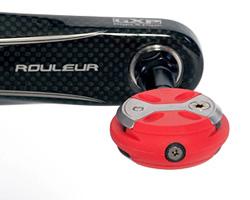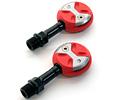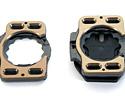
Recently on Cyclingnews.com |
On test: Speedplay Light Action pedals, March 26, 2007
Low-effort clipless pedals for the masses

|
Speedplay has long been renowned for its 'outside the box' approach to pedal design, having produced a series of different, but successful, models for both on and off-road use. Now the California-based company says its latest creation, the Light Action road pedal, boasts the easiest and most intuitive operation of any clipless pedal system, bar none. Cyclingnews' Ben Abrahams got hold of a pair to find out for himself just what was so special about Speedplay's newest offering.
Unlike the real thing these days, the marriage between a cyclist and their pedals can often last a lifetime. As such, the decision to change to another pedal system is not usually taken lightly as getting the setup wrong can result in damaged knees and all sorts of other physiological problems. So despite my childlike eagerness to test some new gear, not being a regular Speedplay user brought a certain degree of apprehension when the Light Action pedals turned up at the Cyclingnews HQ in Sydney a few months ago.

|
Upon opening the box, my initial reaction was, 'how are these things any different to Speedplay's other road pedals?'. However, like its Zero and X-Series brothers, most of the Light Action's magic is tucked away in the cleat mechanism, rather than being displayed on the pedal body itself. The new design is based around a much milder, lower tension spring in the cleat which reduces the amount of effort required to clip in to and/or twist out of the pedal.
Because of that same reduced-effort release, however, Speedplay says that it isn't possible to precisely reign in the amount of rotational float as it is with its more race-specific Zeros. Consequently, there are no adjuster screws on the cleats, allowing the foot to swing through as much as 15° of rotation before feeling the release mechanism.
Aimed at first time clipless pedal users and the recreational cyclist market in general, the Light Action's black chrome-moly spindles aren't quite as svelte in the looks department as compared to the stainless steel or titanium versions available on the Zeros. To be honest, though, does anyone really spend much time admiring their pedals? For those that do, a set of matching black carbon fiber cranks took care of the issue quite handily…
Installation time; are you sitting comfortably?

|
Despite the perfectly visible warning printed smack bang in the middle of the instruction leaflet which said, 'Failure to follow these instructions and warning statements before assembling and using this system may result in serious personal injury', I naturally decided to ignore all such directions and proceed straight to installation armed only with a very limited knowledge of Speedplay pedals and a set of Allen keys. Well, needless to say, this was something of a mistake.
The Light Actions require that the supplied three-hole (Look-style) compatible base plates fit snugly along the contours of the bottom of the shoe in order to function properly. Given the wide range of curvatures possible with the multitude of shoe makes, models, and sizes on the market, that precise fit isn't always a given straight out of the box.
As such, Speedplay supplies a multitude of 'snap shims' and a detailed fitment guide covering an impressive assortment of shoes to help guarantee a proper installation. These small pieces of plastic sit between the base plate and the sole itself to prevent the cleat from deforming excessively, which can adversely affect pedal function. If using a four-hole mounting system, the thin three-hold adapter plate can be omitted entirely and the cleat mechanism can be screwed directly onto the sole. In this case, however, Speedplay still advises using a protector shim to prevent the cleat and pedal from gnawing away at your favourite shoes.
Will they float your boat?

|
Speedplay's claims of offering the easiest entry of any pedal seems to ring true here, but the ease of engagement takes some getting used to. To be fair, many of Speedplay's intended market for these pedals may have little to no frame of reference for comparison, and more seasoned users may find the lack of a 'clunk' from a higher tension spring to be disconcerting. Likewise, clipping into any of Speedplay's dual-sided road pedals involves an entirely different motion. There's no 'toe first' orientation required or quick check to make sure the pedal is in the correct position; just step down and go.
Once clipped in and on the road, the most noticeable feature is the amount of 'free float' on offer. Speedplay's version of free float has dramatically less friction (and no spring-loaded recentering) as compared to most other pedal systems, which allows your foot to idly wander about the pedal body without any restriction until it reaches the boundary where further twisting would disengage the cleat's locking mechanism.

|
Speedplay argues that this style of float allows the foot to assume its natural position throughout the pedal stroke more readily, thus reducing stress on the knees. However, this also made the first few rides feel more like ice skating than pedaling and I began to wonder how anyone could possibly feel stable whilst standing up on these things. Eventually, however, the sensation of instability disappeared and the whole free float thing began to feel decidedly more natural - even to the point where the prospect of moving back to my old pedals seemed rather unpleasant.
As promised, releasing is equally easy, although the large amount of free float does require you to twist your heel a pretty long way before the spring lets go of the pedal. As an indicator of just how easy the operation is, though, it's perfectly possible to clip and unclip the pedal from the shoe using one hand, a nearly impossible feat with many other systems.
In spite of the lower tension spring, though, Speedplay has still somehow managed to virtually eliminate the possibility of an accidental release, provided your foot remains within the intended range of motion. Throughout the three months of testing there was not one occasion where the pedal released unexpectedly.
To buy or not to buy?

|
Speedplay's official line is that the Light Action pedals are not intended for pure racing, although at just 220g for the pair (not including the somewhat weighty cleats) they certainly don't give much away to the significantly more expensive race-ready Zero or X-Series models . And while three months of riding doesn't exactly constitute a long-term test, there's been no notable issues of yet although the spring's operation does become a little crunchy if faced with rogue dirt or sand particles - so try and stay off the beach with your bike shoes.
Whether you fall for the Light Actions or not will hinge largely on your preference for non-centered free float. Otherwise, the combination of a lighter spring coupled with a double sided design and the pedal's surprisingly secure hold certainly makes for one of the most trouble free day-to-day pedals on the market.
Price: USD$ 115
Weight: Pedals -220g/pair, Cleats - 117g/pair (three-hole platform),
69g/pair (four-hole platform)
Pros: effortless entry and exit, light weight for the price
Cons: free float may not suit all, cleat doesn't like getting bunged
up with dirt
Cyclingnews rating: ![]()
Photography
For a thumbnail gallery of these images, click here
Images by Speedplay Inc
- Speedplay's latest box of tricks : The Light Action pedal system.
Images by Paul Henderson-Kelly/Cyclingnews
- Subtle differences set the Light Actions apart from Speedplay's other road models. The grooving on each side of the pedal body has been reduced so that less torque is required for release.
- Both pedals and cleats have specific left and right designs - install with care!
- A base plate is supplied for mounting on three-hole shoe patterns.
- The chrome-moly spindle will match your carbon fibre cranks rather nicely.
- The built-in grease port behind this exterior screw makes for easy bearing lubrication - naturally, Speedplay recommends that you use Speedplay Grease Gun #13175 and Grease Pack #13170, of course.

